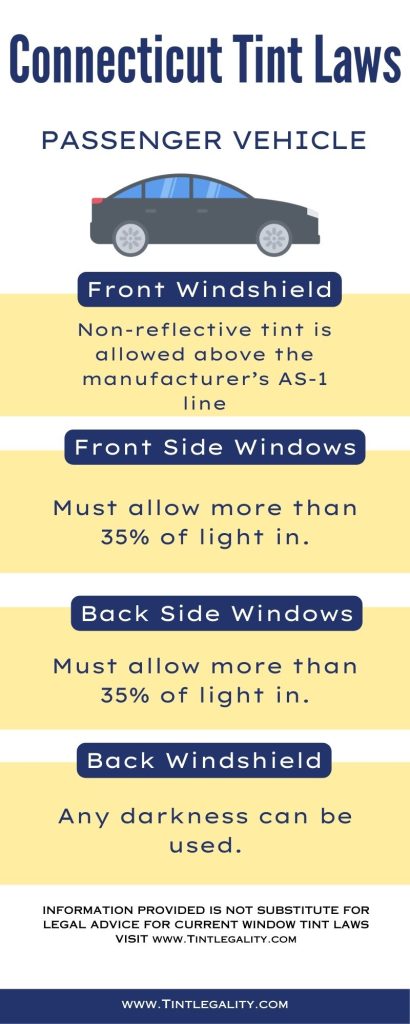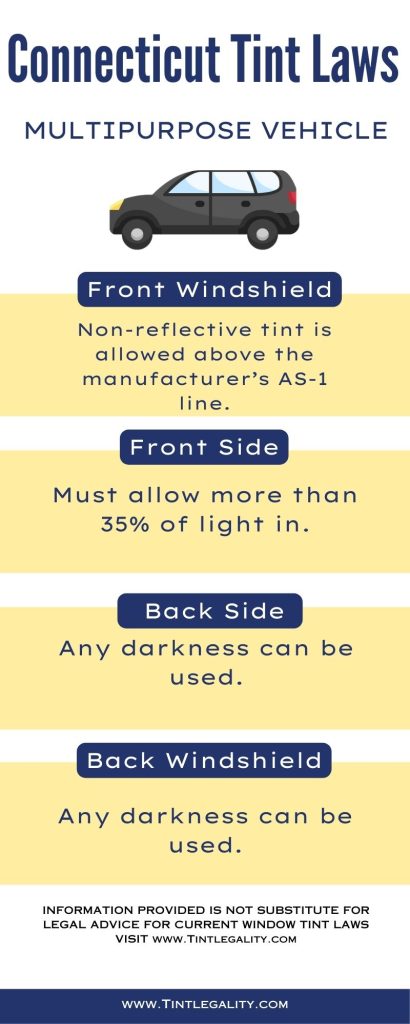If you’re a car owner in Connecticut, you might be wondering about the state’s regulations regarding window tint.
Connecticut tint laws were enacted in 1993, and they are still in effect today.
These laws are designed to ensure that drivers can see and be seen on the road while protecting them from the harmful effects of UV radiation.
In this article, we’ll take a closer look at Connecticut’s tint laws and what you need to know to stay on the right side of the law.
Regulations Regarding Window Tint in Connecticut
In Connecticut, the amount of visible light that can pass through a vehicle’s windows is regulated by law.
The amount of visible light that can pass through the windshield, front side windows, and back side windows is different, and the amount that can pass through the rear window is yet another level.
Here’s what you need to know:
| Window Type | Legal Tint Limit | Penalties for Violation |
|---|---|---|
| Windshield | Not below the AS-1 line | A fine of $150 for the first offense, $250 for a second offense, and $350 for the third offense; possible requirement to remove tint from windows |
| Front Side Windows | At least 35% visible light transmission | A fine of $150 for the first offense, $250 for the second offense, and $350 for the third offense; possible requirement to remove tint from windows |
| Back Side Windows | A fine of $150 for first offense, $250 for second offense, and $350 for third offense; possible requirement to remove tint from windows | Fine of $150 for first offense, $250 for second offense, and $350 for third offense; possible requirement to remove tint from windows |
| Rear Window | Any degree of tinting, as long as vehicle has side mirrors providing a view behind the vehicle | Fine of $150 for first offense, $250 for second offense, and $350 for third offense; possible requirement to remove tint from windows |
Windshield
The windshield is not allowed to be tinted below the AS-1 line, which is located approximately 4-5 inches below the top of the windshield.
Front Side Windows
The front side windows (the driver’s side and front passenger’s side windows) must allow at least 35% of visible light to pass through.
Back Side Windows
The back-side windows (behind the driver’s seat and behind the front passenger’s seat) can be tinted to any degree, as long as the vehicle has side mirrors that provide a view behind the car.
Rear Window
The rear window can also be tinted to any degree, as long as the vehicle has side mirrors that provide a view behind the car.


Additional Regulations
There are several additional regulations that drivers in Connecticut need to be aware of when it comes to window tint. Here are some of the most important ones:
Reflection
Window tint cannot reflect more than 27% of light.
Medical Exemptions
Drivers with certain medical conditions may be exempt from the window tint regulations.
To qualify for a medical exemption, a driver must obtain a prescription from a licensed physician.
Color Restrictions
Window tint cannot be red, blue, or yellow.
Side Mirrors
Vehicles with tinted windows must have side mirrors that provide a view behind the vehicle.
Exceptions to Legal Limits
There are a few exceptions to the legal limits on window tint in Connecticut. These include:
- Vehicles used for law enforcement or other emergency purposes
- Limousines and other vehicles used for chauffeured transportation
- Vehicles used for transporting prisoners
- Vehicles used for funeral processions
Penalties for Breaking the Law
If you’re caught violating Connecticut’s window tint laws, you could face penalties. Here’s what you need to know:
Fines
The fine for a first-time offense is $150. The fine for a second offense is $250, and the fine for a third offense is $350.
First Conviction
In addition to the fine, a driver who is convicted of violating Connecticut’s window tint laws may also be required to remove the tint from their windows.
Second Conviction
A second conviction for violating the window tint laws may result in a suspension of the driver’s license.
Third Conviction
A third conviction for violating the window tint laws may result in the revocation of the driver’s license.
Other Penalties
In addition to fines and license-related penalties, a driver who is convicted of violating the window tint laws may also be required to perform community service or attend a driver improvement program.
Penalties for Non-Compliance
If a vehicle is found to be non-compliant with Connecticut’s window tint laws during a safety inspection, the vehicle will not pass the inspection. This means that the driver will not be able to renew their vehicle registration until the tint is removed and the vehicle passes.
Is 5% tint legal in CT?
No, 5% tint is not legal in CT.
Can you get pulled over for tint CT?
Yes, you can get pulled over for illegal tint in CT.
Is 20% tint all-around legal?
No, 20% tint all around is not legal in CT.
What are the darkest tints?
The darkest legal tint in CT is 35%.
Are tinted tail lights illegal in CT?
Yes, tinted tail lights are illegal in CT.
References:
https://en.wikipedia.org/wiki/Connecticut
https://www.cga.ct.gov/current/pub/chap_246.htm#sec_14-99g
https://portal.ct.gov/DMV/Dealers-and-Repairs/Dealers-and-Repairs/Quick-Reference-on-Tinted-Windows